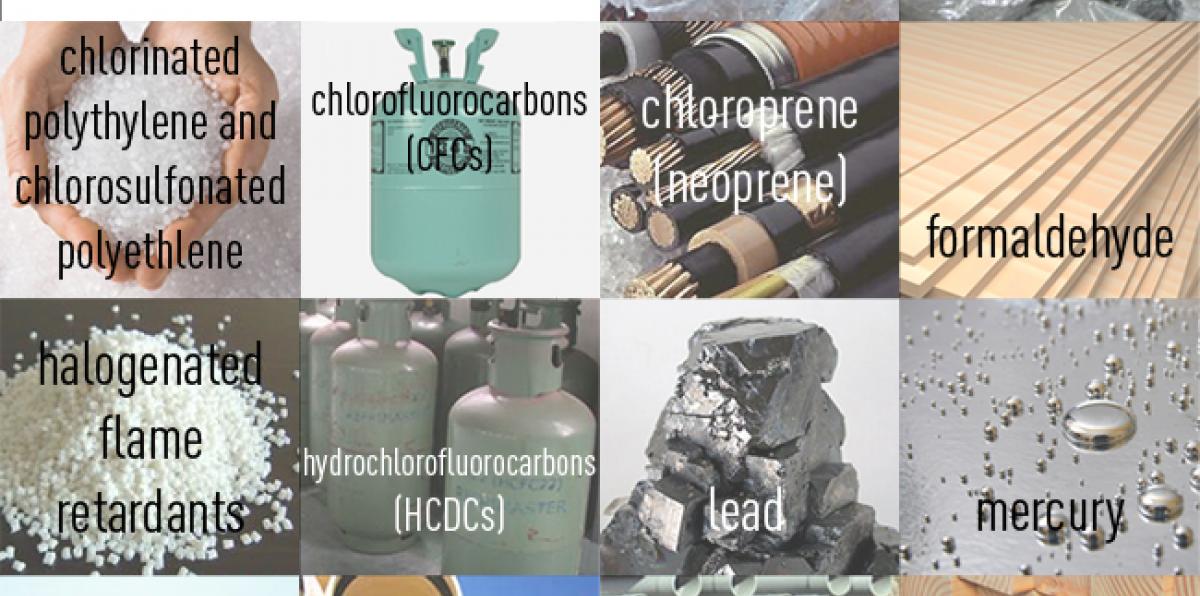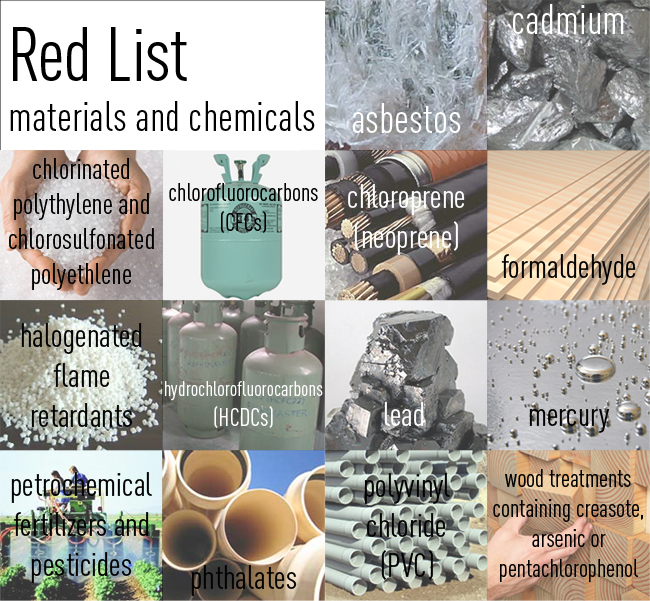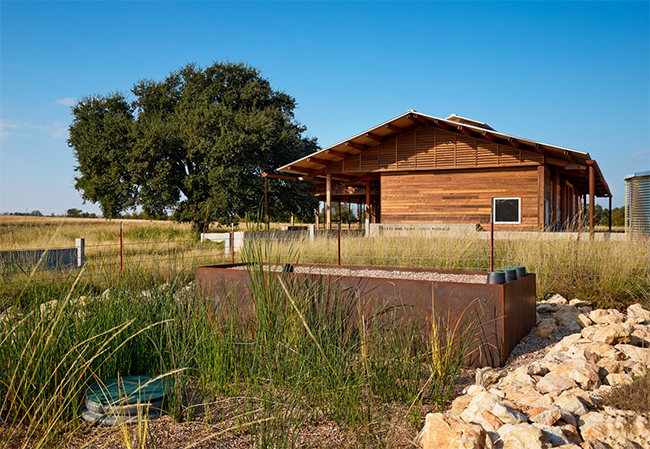THE DOGRUN
a place to share ideas


Trail toward Transparency: the process
Posted by coreysquire on 5/21/15 at 11:20 am
Of the 20 imperatives of the Living Building Challenge, the two that we found to be most difficult were Red List and Appropriate Sourcing. Following up on our recent publication of the material matrix for the Josey Pavilion, here’s a look at how we tackled these two challenges.
Imperative 11: Red List
The Red List contains 13 chemicals that should not exist in the built environment and are not permitted anywhere in a living building. Some chemicals on the list, Chlorofluorocarbons (CFCs) and asbestos, were easy to avoid as they have been phased out of the material economy through regulation due to their negative health or environmental effects. Other chemicals, such as polyvinyl-chloride (PVC) and formaldehyde, are ubiquitous in materials throughout the construction industry. Formaldehyde, a known human carcinogen according to the US National Toxicology Program, is common in a wide range of products including manufactured wood such as plywood and particle board, construction adhesives, sealants, insulation, paints, and many other products.
 PVC is a flexible and stable plastic that is commonly used for drain pipes, flooring, gaskets, wire insulation, tape, and many other everyday products (including wrinkle free shirts!). While stable as a finished product, PVC's manufacturing process is dirty, resulting in released dioxins and other harmful byproducts. PVC often contains phthalate plasticizers and lead as a stabilizer, two other red list chemicals. If PVC is burned, the contained lead will aerosolize and can be inhaled or enter the local ecosystem.
One PVC alternative is Polypropylene (PP) a clean, stable, and infinitely recyclable plastic that is commonly used for athletic clothing and food storage containers. Josey Pavilion's waste and irrigation lines, gaskets, geotextiles, and the water tight lining in the rainwater cistern are all made of PP.
PVC is a flexible and stable plastic that is commonly used for drain pipes, flooring, gaskets, wire insulation, tape, and many other everyday products (including wrinkle free shirts!). While stable as a finished product, PVC's manufacturing process is dirty, resulting in released dioxins and other harmful byproducts. PVC often contains phthalate plasticizers and lead as a stabilizer, two other red list chemicals. If PVC is burned, the contained lead will aerosolize and can be inhaled or enter the local ecosystem.
One PVC alternative is Polypropylene (PP) a clean, stable, and infinitely recyclable plastic that is commonly used for athletic clothing and food storage containers. Josey Pavilion's waste and irrigation lines, gaskets, geotextiles, and the water tight lining in the rainwater cistern are all made of PP.
 While PVC has a few safer substitutions, formaldehyde proved to be more difficult to avoid. Formaldehyde exists in almost all construction adhesives, from the glue that holds plywood together to adhesives for cork wallboards. We were able to source formaldehyde free plywood, but like many formaldehyde free alternatives, the choices are limited and the substituting chemical is proprietary. For our cork board adhesive, we were forced to produce due diligence documentation because alternative chemicals are not available. We did, however, have some major formaldehyde successes to celebrate. We were able to completely eliminate formaldehyde from paints, wood sealants, insulation, and many other products.
What's most exciting about the material research that we invested in for our first LBC project is how our new knowledge of material safety is spreading throughout the firm and alternative products are finding their way into many of our projects. After using PP pipes on Josey, PP is our first choice for waste and irrigation lines throughout the office. The formaldehyde free products that we specified for Josey are finding their way into projects throughout our residential and commercial studios. We have found that a healthy interior environment is becoming increasingly important to our residential clients. Our Red List research for Josey has given us a competitive advantage in interviews when clients have strong materials safely concerns.
Imperative 14: Appropriate Sourcing
At the beginning of the project, it looked like the red list would be the biggest challenge. It turned out that “Imperative 14: Appropriate Sourcing”, was even more challenging. A company might have a reason for claiming proprietary ingredients or to be skeptical to sign a document stating a product’s material contents. But generally, there is knowledge as to what a product is made from.
However, when it comes to location, some big companies likely have no idea where an individual product, like a tube of silicone caulk, was manufactured. It's possible that components of one tube are extracted from locations all over the world, or that two tubes sitting alongside one another on a shelf were manufactured at facilities on different continents. Since chemical components of products are (moderately) regulated, but manufacturing locations are not, manufacturing locations are often much more difficult to find and document. The solution was to rely on Google Earth. Through our process of finding an address and verifying its authenticity with satellite images, we became familiar with the appearance of different types of manufacturing facilities from the air. Steel plants are accessed by railroad tracks and have adjacent power plants for melting iron. Lumber mills are easy to spot by their rows of neatly laid out tree trunks. A gypsum mine looks like a huge white spot from the air with white tire tracks leading away. An unforeseen joy of LBC material documentation was the simultaneously beautiful and devastating images of our manufacturing landscape.
While PVC has a few safer substitutions, formaldehyde proved to be more difficult to avoid. Formaldehyde exists in almost all construction adhesives, from the glue that holds plywood together to adhesives for cork wallboards. We were able to source formaldehyde free plywood, but like many formaldehyde free alternatives, the choices are limited and the substituting chemical is proprietary. For our cork board adhesive, we were forced to produce due diligence documentation because alternative chemicals are not available. We did, however, have some major formaldehyde successes to celebrate. We were able to completely eliminate formaldehyde from paints, wood sealants, insulation, and many other products.
What's most exciting about the material research that we invested in for our first LBC project is how our new knowledge of material safety is spreading throughout the firm and alternative products are finding their way into many of our projects. After using PP pipes on Josey, PP is our first choice for waste and irrigation lines throughout the office. The formaldehyde free products that we specified for Josey are finding their way into projects throughout our residential and commercial studios. We have found that a healthy interior environment is becoming increasingly important to our residential clients. Our Red List research for Josey has given us a competitive advantage in interviews when clients have strong materials safely concerns.
Imperative 14: Appropriate Sourcing
At the beginning of the project, it looked like the red list would be the biggest challenge. It turned out that “Imperative 14: Appropriate Sourcing”, was even more challenging. A company might have a reason for claiming proprietary ingredients or to be skeptical to sign a document stating a product’s material contents. But generally, there is knowledge as to what a product is made from.
However, when it comes to location, some big companies likely have no idea where an individual product, like a tube of silicone caulk, was manufactured. It's possible that components of one tube are extracted from locations all over the world, or that two tubes sitting alongside one another on a shelf were manufactured at facilities on different continents. Since chemical components of products are (moderately) regulated, but manufacturing locations are not, manufacturing locations are often much more difficult to find and document. The solution was to rely on Google Earth. Through our process of finding an address and verifying its authenticity with satellite images, we became familiar with the appearance of different types of manufacturing facilities from the air. Steel plants are accessed by railroad tracks and have adjacent power plants for melting iron. Lumber mills are easy to spot by their rows of neatly laid out tree trunks. A gypsum mine looks like a huge white spot from the air with white tire tracks leading away. An unforeseen joy of LBC material documentation was the simultaneously beautiful and devastating images of our manufacturing landscape.

 PVC is a flexible and stable plastic that is commonly used for drain pipes, flooring, gaskets, wire insulation, tape, and many other everyday products (including wrinkle free shirts!). While stable as a finished product, PVC's manufacturing process is dirty, resulting in released dioxins and other harmful byproducts. PVC often contains phthalate plasticizers and lead as a stabilizer, two other red list chemicals. If PVC is burned, the contained lead will aerosolize and can be inhaled or enter the local ecosystem.
One PVC alternative is Polypropylene (PP) a clean, stable, and infinitely recyclable plastic that is commonly used for athletic clothing and food storage containers. Josey Pavilion's waste and irrigation lines, gaskets, geotextiles, and the water tight lining in the rainwater cistern are all made of PP.
PVC is a flexible and stable plastic that is commonly used for drain pipes, flooring, gaskets, wire insulation, tape, and many other everyday products (including wrinkle free shirts!). While stable as a finished product, PVC's manufacturing process is dirty, resulting in released dioxins and other harmful byproducts. PVC often contains phthalate plasticizers and lead as a stabilizer, two other red list chemicals. If PVC is burned, the contained lead will aerosolize and can be inhaled or enter the local ecosystem.
One PVC alternative is Polypropylene (PP) a clean, stable, and infinitely recyclable plastic that is commonly used for athletic clothing and food storage containers. Josey Pavilion's waste and irrigation lines, gaskets, geotextiles, and the water tight lining in the rainwater cistern are all made of PP.
 While PVC has a few safer substitutions, formaldehyde proved to be more difficult to avoid. Formaldehyde exists in almost all construction adhesives, from the glue that holds plywood together to adhesives for cork wallboards. We were able to source formaldehyde free plywood, but like many formaldehyde free alternatives, the choices are limited and the substituting chemical is proprietary. For our cork board adhesive, we were forced to produce due diligence documentation because alternative chemicals are not available. We did, however, have some major formaldehyde successes to celebrate. We were able to completely eliminate formaldehyde from paints, wood sealants, insulation, and many other products.
What's most exciting about the material research that we invested in for our first LBC project is how our new knowledge of material safety is spreading throughout the firm and alternative products are finding their way into many of our projects. After using PP pipes on Josey, PP is our first choice for waste and irrigation lines throughout the office. The formaldehyde free products that we specified for Josey are finding their way into projects throughout our residential and commercial studios. We have found that a healthy interior environment is becoming increasingly important to our residential clients. Our Red List research for Josey has given us a competitive advantage in interviews when clients have strong materials safely concerns.
Imperative 14: Appropriate Sourcing
At the beginning of the project, it looked like the red list would be the biggest challenge. It turned out that “Imperative 14: Appropriate Sourcing”, was even more challenging. A company might have a reason for claiming proprietary ingredients or to be skeptical to sign a document stating a product’s material contents. But generally, there is knowledge as to what a product is made from.
However, when it comes to location, some big companies likely have no idea where an individual product, like a tube of silicone caulk, was manufactured. It's possible that components of one tube are extracted from locations all over the world, or that two tubes sitting alongside one another on a shelf were manufactured at facilities on different continents. Since chemical components of products are (moderately) regulated, but manufacturing locations are not, manufacturing locations are often much more difficult to find and document. The solution was to rely on Google Earth. Through our process of finding an address and verifying its authenticity with satellite images, we became familiar with the appearance of different types of manufacturing facilities from the air. Steel plants are accessed by railroad tracks and have adjacent power plants for melting iron. Lumber mills are easy to spot by their rows of neatly laid out tree trunks. A gypsum mine looks like a huge white spot from the air with white tire tracks leading away. An unforeseen joy of LBC material documentation was the simultaneously beautiful and devastating images of our manufacturing landscape.
While PVC has a few safer substitutions, formaldehyde proved to be more difficult to avoid. Formaldehyde exists in almost all construction adhesives, from the glue that holds plywood together to adhesives for cork wallboards. We were able to source formaldehyde free plywood, but like many formaldehyde free alternatives, the choices are limited and the substituting chemical is proprietary. For our cork board adhesive, we were forced to produce due diligence documentation because alternative chemicals are not available. We did, however, have some major formaldehyde successes to celebrate. We were able to completely eliminate formaldehyde from paints, wood sealants, insulation, and many other products.
What's most exciting about the material research that we invested in for our first LBC project is how our new knowledge of material safety is spreading throughout the firm and alternative products are finding their way into many of our projects. After using PP pipes on Josey, PP is our first choice for waste and irrigation lines throughout the office. The formaldehyde free products that we specified for Josey are finding their way into projects throughout our residential and commercial studios. We have found that a healthy interior environment is becoming increasingly important to our residential clients. Our Red List research for Josey has given us a competitive advantage in interviews when clients have strong materials safely concerns.
Imperative 14: Appropriate Sourcing
At the beginning of the project, it looked like the red list would be the biggest challenge. It turned out that “Imperative 14: Appropriate Sourcing”, was even more challenging. A company might have a reason for claiming proprietary ingredients or to be skeptical to sign a document stating a product’s material contents. But generally, there is knowledge as to what a product is made from.
However, when it comes to location, some big companies likely have no idea where an individual product, like a tube of silicone caulk, was manufactured. It's possible that components of one tube are extracted from locations all over the world, or that two tubes sitting alongside one another on a shelf were manufactured at facilities on different continents. Since chemical components of products are (moderately) regulated, but manufacturing locations are not, manufacturing locations are often much more difficult to find and document. The solution was to rely on Google Earth. Through our process of finding an address and verifying its authenticity with satellite images, we became familiar with the appearance of different types of manufacturing facilities from the air. Steel plants are accessed by railroad tracks and have adjacent power plants for melting iron. Lumber mills are easy to spot by their rows of neatly laid out tree trunks. A gypsum mine looks like a huge white spot from the air with white tire tracks leading away. An unforeseen joy of LBC material documentation was the simultaneously beautiful and devastating images of our manufacturing landscape.

